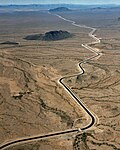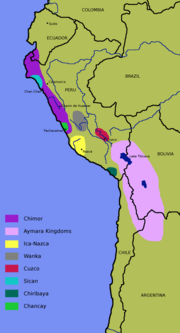The Inca aqueducts refer to any of a series of aqueducts built by the Inca people. The Inca built such structures to increase arable land and provide...
17 KB (2,286 words) - 22:17, 14 November 2024
and ancient Inca. The simplest aqueducts are small ditches cut into the earth. Much larger channels may be used in modern aqueducts. Aqueducts sometimes...
20 KB (2,446 words) - 04:17, 11 October 2024
Chilean Inca Trail Aclla, the "chosen women" Amauta, Inca teachers Amazonas before the Inca Empire Anden, agricultural terrace Inca cuisine Inca aqueducts List...
111 KB (12,928 words) - 15:33, 13 November 2024
82667°S 74.91028°W / -14.82667; -74.91028 The Cantalloc Aqueducts are a series of aqueducts located 4 kilometres (2.5 miles) west of the city of Nazca...
2 KB (188 words) - 19:10, 21 October 2024
Andean civilizations (redirect from Inca people)
Less than a century prior to the arrival of the Spanish conquerors, the Incas, from their homeland centered on the city of Cusco, united most Andean cultures...
35 KB (4,030 words) - 15:53, 25 October 2024
Cápac Yupanqui (category Inca emperors)
(Quechua Qhapaq Yupanki Inka, "splendid accountant Inca") (c. 1320 – c. 1350) was the fifth Sapa Inca of the Kingdom of Cusco (beginning around CE 1320)...
3 KB (243 words) - 06:19, 29 June 2024
The Tawantinsuyu (Quechua: "land of the four quarters") or Inca Empire was a centralized bureaucracy. It drew upon the administrative forms and practices...
28 KB (3,346 words) - 16:24, 11 October 2024
Mit'a (redirect from Mita (Inca))
(Quechua pronunciation: [ˈmɪˌtʼa]) was mandatory service in the society of the Inca Empire. Its close relative, the regionally mandatory Minka is still in use...
22 KB (2,891 words) - 05:51, 11 October 2024
and preserving technologies like the aqueducts of Cumbe Mayo (c. 1500 BCE) and the Nazca's underground aqueducts called Puquios (date uncertain), or the...
12 KB (1,475 words) - 22:07, 11 November 2024
Cusco (category 13th-century establishments in the Inca civilization)
elevation is around 3,400 m (11,200 ft). The city was the capital of the Inca Empire until the 16th-century Spanish conquest. In 1983, Cusco was declared...
75 KB (7,127 words) - 01:16, 16 November 2024
The Inca complex at Pisac is a large Incan complex of agricultural terraces, residences, guard posts, watchtowers and a ceremonial/religious centre located...
30 KB (3,955 words) - 04:05, 28 October 2024
Inca Empire, located near Cusco, Peru. An alternate Spanish name is El Baño del Inca ("the bath of the Inca"). It consists of a series of aqueducts,...
5 KB (419 words) - 07:25, 6 September 2024
Periodization of pre-Columbian Peru (redirect from Pre-Inca cultures)
the Late Intermediate joined the Inca Empire by 1493, but the period ends in 1532 because that marks the fall of the Inca Empire after the Spanish conquest...
6 KB (208 words) - 14:50, 5 October 2024
runoff to occur through the outlet. The Inca people built on these, developing a system of canals, aqueducts, and puquios to direct water through dry...
15 KB (1,619 words) - 09:36, 9 July 2024
Ingapirca (category Inca)
Ingapirca (Kichwa: Inka Pirka, "Inca wall") is a town in Cañar Province, Ecuador, and the name of the older Inca ruins and archeological site nearby. These...
7 KB (588 words) - 22:04, 4 November 2024
Kevin (2016). "Chapter 27 Puquios and Aqueducts in the Central Andes of South America". Underground Aqueducts Handbook. p. 465. Ted E Barker (October...
15 KB (1,337 words) - 06:27, 30 October 2024
Vertical archipelago (category Inca)
barter and shared labor. These reached their greatest development under the Inca Empire. Scholars have identified four distinct ecozones, at different elevations...
9 KB (1,143 words) - 20:05, 12 November 2024
Ancient Roman architecture (section Aqueduct)
clean and free from effluent. Aqueducts also provided water for mining operations, milling, farms and gardens. Aqueducts moved water through gravity alone...
100 KB (12,310 words) - 19:53, 8 November 2024
Puquios (category Aqueducts in Peru)
Aqueducts in the Central Andes of South America". Underground Aqueducts Handbook. Boca Raton, Florida: CRC Press: 465–467.. In Underground Aqueducts Handbook...
29 KB (2,565 words) - 06:55, 6 October 2024
Tipón (category Inca)
Tipón is a sprawling early fifteenth-century Inca archaeological site that is situated between 3,250 metres (10,660 ft) and 3,960 metres (12,990 ft) above...
22 KB (2,925 words) - 22:28, 26 September 2024
people erroneously assume that this is because its original Inca name is "Talking River" (the Incas spoke a highland variety of Quechua, in which the word...
156 KB (16,298 words) - 01:06, 18 November 2024
pumps). The Inca later expanded on these previously constructed aqueducts and built a more complex and large aqueduct system in the Inca Empire. The Mesoamerican...
58 KB (7,313 words) - 10:21, 20 October 2024
culminated in the expansion of the Inca civilization and Inca Empire in the central Andes during the 15th century. The Incas formed this civilization through...
60 KB (6,962 words) - 17:05, 18 November 2024
1476 AD – 1534 AD Ecuador, Peru, Bolivia, Argentina, Chile, and Colombia: Inca Empire; Brazil: Cambeba; Colombia: Muisca Confederation Argentina: Diaguita...
15 KB (1,091 words) - 06:26, 16 October 2024
century BC through the 7th century AD. They have left us their wonderful aqueducts that made good use of underground water, of rivers and rain, showing a...
12 KB (1,087 words) - 19:25, 25 October 2024
The Inca used rope bridges, documented as early as 1615. It is not known when they were first made. Queshuachaca is considered the last remaining Inca rope...
43 KB (4,724 words) - 23:22, 19 October 2024
Quechua and have vibrant cultural traditions, some of which were part of the Inca Empire.[citation needed] Dozens of Peruvian cultures are also dispersed throughout...
35 KB (3,522 words) - 08:16, 25 October 2024
the gate and pay a toll to the Inca. This theory suggests that the Inca also modified La Portada to serve as an aqueduct. This theory likely attempted...
5 KB (644 words) - 07:12, 26 February 2022
designs in the desert whose purpose is unknown, and puquios, underground aqueducts for providing water for irrigation and domestic purposes in the arid environment...
34 KB (4,609 words) - 14:13, 13 November 2024
























